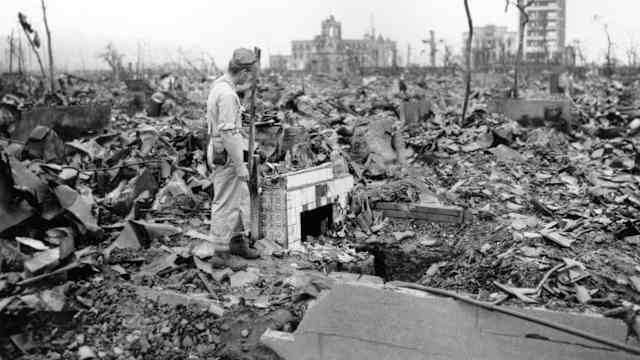Enrico Fermi, the Italian-born Nobel Prize-winning physicist, directs and controls the first nuclear chain reaction in his laboratory beneath the bleachers of Stagg Field at the University of Chicago, ushering in the nuclear age. Upon successful completion of the experiment, a coded message was transmitted to President Roosevelt: “The Italian navigator has landed in the new world.”

By: HISTORY.com Editors
1942
Physicist Enrico Fermi produces the first nuclear chain reaction
Published: November 16, 2009
Last Updated: January 24, 2025
Atomic Bomb History
Explore the top-secret American project to build the world's first atomic bomb.
Following on England’s Sir James Chadwick’s discovery of the neutron and the Curies’ production of artificial radioactivity, Fermi, a full-time professor of physics at the University of Florence, focused his work on producing radioactivity by manipulating the speed of neutrons derived from radioactive beryllium. Further similar experimentation with other elements, including uranium 92, produced new radioactive substances; Fermi’s colleagues believed he had created a new “transuranic” element with an atomic number of 93, the result of uranium 92 capturing a neuron while under bombardment, thus increasing its atomic weight.
Fermi remained skeptical about his discovery, despite the enthusiasm of his fellow physicists. He became a believer in 1938, when he was awarded the Nobel Prize in physics for “his identification of new radioactive elements.” Although travel was restricted for men whose work was deemed vital to national security, Fermi was given permission to leave Italy and go to Sweden to receive his prize. He and his wife, Laura, who was Jewish, never returned; both feared and despised Mussolini’s fascist regime.
Fermi immigrated to New York City—Columbia University, specifically, where he recreated many of his experiments with Niels Bohr, the Danish-born physicist, who suggested the possibility of a nuclear chain reaction. Fermi and others saw the possible military applications of such an explosive power, and quickly composed a letter warning President Roosevelt of the perils of a German atomic bomb. The letter was signed and delivered to the president by Albert Einstein on October 11, 1939. The Manhattan Project, the American program to create its own atomic bomb, was the result.
It fell to Fermi to produce the first nuclear chain reaction, without which such a bomb was impossible. He created a jerry-rigged laboratory with the necessary equipment, which he called an “atomic pile,” in a squash court in the basement of Stagg Field at the University of Chicago. With colleagues and other physicists looking on, Fermi produced the first self-sustaining nuclear chain reaction and the “new world” of nuclear power was born.
Timeline
Also on This Day in History
Discover more of the major events, famous births, notable deaths and everything else history-making that happened on December 2nd
Related Articles

World War II
World War II-Era Flood Was the Worst in D.C.’s History
While the war raged overseas, soldiers and civilians worked furiously to protect the capital against rising waters.

World War II
World War II Bombings Were So Powerful They Sent Shockwaves to Space
Many Allied bombings released the equivalent energy of 300 lightning strikes and temporarily weakened the ionosphere, say researchers.

World War II
Museums Still Can’t Agree on How to Talk About the 1945 Atomic Bombing of Japan
The Los Alamos Historical Museum halted a Japanese exhibition on the bombings of Hiroshima and Nagasaki because of a controversy over its message of abolishing nuclear weapons.

World War II
The WWII Spy Who Faked His Death for 36 Years
British intelligence called Juan Pujiol Garcia 'Agent Garbo' because he was so good at assuming new identities.
About the author
HISTORY.com Editors
HISTORY.com works with a wide range of writers and editors to create accurate and informative content. All articles are regularly reviewed and updated by the HISTORY.com team. Articles with the “HISTORY.com Editors” byline have been written or edited by the HISTORY.com editors, including Amanda Onion, Missy Sullivan, Matt Mullen, Christian Zapata and Cristiana Lombardo.
Fact Check
We strive for accuracy and fairness. But if you see something that doesn't look right, click here to contact us! HISTORY reviews and updates its content regularly to ensure it is complete and accurate.
Citation Information
- Article title
- Physicist Enrico Fermi produces the first nuclear chain reaction
- Author
- HISTORY.com Editors
- Website Name
- History
- Date Accessed
- April 22, 2025
- Publisher
- A&E Television Networks
- Last Updated
- January 24, 2025
- Original Published Date
- November 16, 2009
History Every Day
Sign Up for "This Day in History"
Uncover fascinating moments from the past every day! Learn something new with key events in history, from the American Revolution to pop culture, crime and more.
By submitting your information, you agree to receive emails from HISTORY and A+E Global Media. You can opt out at any time. You must be 16 years or older and a resident of the United States.
More details: Privacy Policy | Terms of Use | Contact Us


